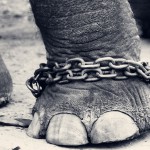 The recent story about Ringling Bros. dropping their elephant act (post dated to 2018) had many mainstream animal rights organisations rejoicing at the ‘victory’. However, away from the celebrations, there seemed to be few questions asked about what was going to happen to the elephants next? When will other animal acts in the circus end? Or contemplation about how this fits into the broader context of animal liberation.
The recent story about Ringling Bros. dropping their elephant act (post dated to 2018) had many mainstream animal rights organisations rejoicing at the ‘victory’. However, away from the celebrations, there seemed to be few questions asked about what was going to happen to the elephants next? When will other animal acts in the circus end? Or contemplation about how this fits into the broader context of animal liberation.
When we first look at the animal circus, we can identify a traditional reliance on class to promote the business model. We have been raised to feel awe inspired by the ‘great’ animals: tigers, lions, elephants, orca, and bears, have all subsequently appeared as a main attraction. These ‘powerful’ animals are held up as having the capacity to dominate others (usually through predation), whilst also possessing an enhanced ability to shape their environment. In the circus they appear to fall furthest when tamed (domesecrated) to perform the cheap tricks that also exemplify human superiority. This view of animals reflects a hierarchical perspective that tends to take precedence over examples of co-operation and organisation that can be considered equally remarkable.
The media stories about the elephants focussed on reaction from mainstream animal groups. Ingrid Newkirk talked about the years Peta had spent protesting against elephant use, but mainly overlooked the other animals imprisoned and forced to participate in demeaning acts. Peta have since claimed that Ringling bros. were forced to retire the elephants because of chronic illness, and are consequently manipulating the situation to demonstrate how responsive they are to public concern.
HSUS forgot their recent embarrassment regarding circus animals, and celebrated that people no longer believed bullhooks were for elephants. Conveniently overlooking the fact they never had to be for elephants at all.
The broader classification of animals into different groups has meant that many activists chase one issue after another. Essentially fighting fires when animal suffering is raised in the media, and as a consequence, rarely addressing the structural issue of animal exploitation and the Animal Industrial Complex. This approach objectifies progress in the language of short term ‘victories’, whilst often providing a vehicle for self-promotion that fails to reflect the philosophy of animal liberation. This is not to say there can’t be achievements along the way, where animals will suffer less because of pressure placed on exploiters. However, our progress is hindered by focussing on incremental changes made by industry, rather than clearly presenting the ideas and practices consistent with animal liberation.
In broader terms, it seems to make little sense to discriminate between elephants and camels, or between seals and orcas. So why do we protest in such a way that infers a priority to free different species? We can protest about certain forms of animal exploitation, but it only makes sense if we concurrently draw attention to the context of animal liberation. It is only from the anthropocentric perspective that animals are divided into groups to be consumed in a variety of ways. So it is this very anthropocentrism that needs to be challenged. Instead of celebrating these incremental changes sanctioned by animal exploiters, we need to draw attention to their assumed ‘right’ to use animals, otherwise the issue of animal exploitation is not addressed on a fundamental level. Their ability to separate exploited animals is essentially a divide and rule tactic that we ought to be more aware of, and one that we should clearly oppose rather than re-enforce tacitly or otherwise.
It is true that media generally offers little help when attempting to get this message across, especially where circuses and other animal exploiters contribute to the advertising revenue stream. However, a great deal of the way we communicate can take place at a grassroots level where we can decide for ourselves the message we want to put across. This allows us to be clear that change is reliant on understanding how the system of animal exploitation functions. So, in order to address that situation we need to make evident an inclusive approach to animal liberation, emphasising veganism as a core tenet that provides people with a framework for action.
Further reading:
‘From animals to anarchism’ by Kevin Watkinson and Donal O’Driscoll (2014).
‘Fear of the Animal Planet: The Hidden History of Animal Resistance’ by Jason Hribal (2011).
‘Animal oppression and Human Violence: Domesecration, Capitalism and Global Conflict’ by David Nibert (2013).
‘Protest Inc. The Corporatization of Activism’ by Peter Dauvergne and Genevieve Lebaron (2014).
